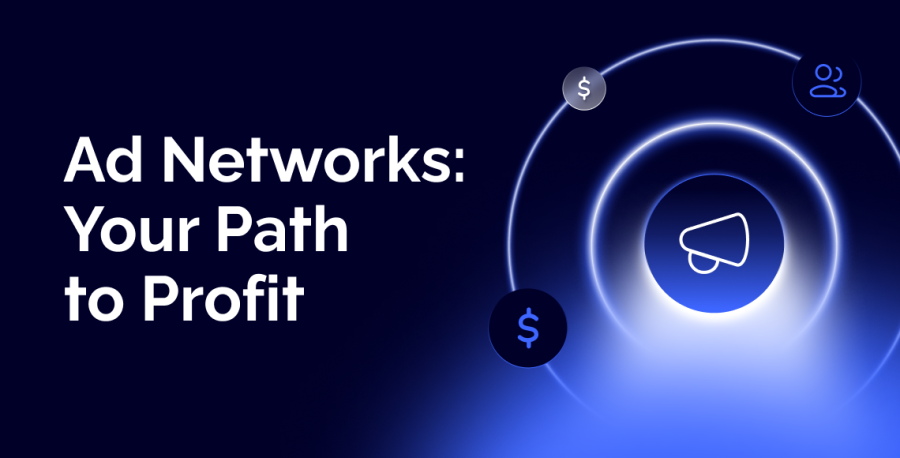Since its inception a few decades ago, performance marketing has given rise to specialization and standardization. Instead of searching for products to promote (a.k.a. offers) manually, you can get in touch with either an affiliate network or program. And instead of searching for traffic sources manually, you can rely on an advertising network to provide the most optimal zones and feeds for you.
It’s time to discuss ad networks so that you, as an advertiser, understand the benefits of working with them. It’s not only about the accessibility of traffic sources but also about established infrastructure, cutting-edge tools, personal assistance, and more. Stop struggling alone and start working with professionals to level up your skills in affiliate marketing.
Ad platforms are typically used by two types of users: in-house marketers (who promote their company’s products) and affiliate marketers (who work with businesses on an outsourced basis). This article focuses on the second group—affiliate marketers.
Ad Network and Where to Look for an Offer

Affiliate marketing has three major parties:
- Business (or product) owners
- Affiliate marketers
- Website owners
Between them, two types of centralized hubs facilitate communication and business affairs: affiliate and advertising networks. As you know, RollerAds is an ad network, meaning we connect affiliate marketers with website owners; we label them as advertisers and publishers, respectively. Unless specified otherwise, that’s the general rule in our blog.
However, if we were an affiliate network, the same labels would apply to product owners and affiliate marketers—that’s why affiliate marketers can be both advertisers and publishers, depending on the context.
Our advertisers typically come to us with an offer at hand. You can find these offers in several ways:
- Affiliate network, e.g., CpaRoll. It unites multiple affiliate programs under a single hub.
- Affiliate program, e.g., Amazon Associates. Typically, it focuses on a single or few offers, working for a particular company.
- Offer aggregators, e.g., Offervault. It combines offers from affiliate networks and programs, giving quick access to their respective offer pages.
Need suggestions on the optimal offers for our traffic? Our managers will help you find the perfect match. Register on our platform and enjoy full-scale support and cutting-edge tools.
Special Word on Affiliate Networks
Affiliate networks are platforms that connect businesses and affiliates. Like ad networks, they simplify communication between both parties. While many companies have their own affiliate programs for direct work, affiliate networks unite various products and services in the form of offers from different brands in one place. This also means you can access multiple campaigns through a single interface, further streamlining your work.
Once affiliates complete their offer target actions, affiliate networks double check the info and pay out money. Such commissions can take multiple forms, but we’ll go through the most typical ones:
- Cost Per Action (CPA)—an umbrella term, referring to all kinds of action from the ones below to some exotic ones, like registering and reaching level 5 in a game or depositing $30.
- Pay Per Sale (PPS)—typically a completed transaction when a user pays from their wallet.
- Pay Per Lead (PPL)—doesn’t have to be a purchase, as sometimes it is enough for the user to complete a registration and wait for the call.
- Single and Double Opt-It (SOI and DOI)—registrations either without or with an email confirmation, typical for sweepstakes and other verticals.
- Revenue Share—the most unique model, enabling recurring commissions instead of one-time payments. If you know how to generate high-intent users, this model works better than CPA.
- Hybrid—some affiliate networks and programs pay out a combination of CPA (fixed) and RevShare (variable) rates. This is an ideal option for transitioning from CPA to RevShare.
Most of these payout models are available from CpaRoll, our trusted partners. Best of all, they offer a variety of payment solutions, so you can claim the money you earn using a convenient payment provider.
Promoting an Offer
Once you find your offer one way or another, you need to promote it. Moreover, you need an exclusive link to attribute your conversions to you accurately. That’s why your affiliate network dashboard has a unique link for you. Here’s what the promotional algorithm looks like on an affiliate network:
- The advertiser places their unique link on a website, leading to the offer page.
- The customer clicks on the link and hopefully completes a target action.
- The conversion is tracked and attributed to the advertiser. However, to track extra details in a single place, such as browsers used, favorite creatives, and user’s OS, you need a tracker.
- Advertiser receives their commission.
In the case of ad networks, affiliates pay for serving the ads. They make bids, and the highest bidder wins the ad auction. Once it happens, a publisher serves the ad and receives a commission for doing so.
But how do affiliates make money in that case?—The answer lies in the difference between how much they spend on an ad network and how much they earn from an affiliate network for completing their target action. That’s also why testing and optimization are important: they help lower costs, leading to higher income. The basic steps of earning revenue are as follows:
- Look and opt for an offer on an affiliate network.
- Get a unique affiliate link.
- Set up a new ad campaign on an ad network, entering targeting settings, depositing money, making creatives, and placing ad auction bids.
- Setting up a tracker for future analytics and micro-management of zones and feeds.
- Wait for the moderation to approve the ad campaign and, if necessary, make the required adjustments.
- Run testing with a limited budget to test the water. This is when your ads become visible to users online. They see them and either click or ignore them. Over time, your budget gradually depletes, and you want to offset it with successfully completed target actions—conversions.
- Track impressions and clicks. Ad networks monitor such metrics by default. If you have a tracker set up, you can track more in-depth details, like user activity, browser used, demographics, etc. Also track the completion of target actions—track it yourself to protect yourself from shaving and other fraudulent activities. Or simply work with a reputable affiliate network.
- Analyze the initial results and optimize traffic sources. If a zone or feed brings no conversions throughout a campaign, you blacklist it; if it converts, you scale it up, allocating a bigger budget and placing higher bids to get more traffic.
- At the end of your ad campaign, you’ll receive a commission from your affiliate network. Your profit is the difference between your campaign expenses and the commission earned.

Extra Ways to Generate Revenue
Additionally, you can refer a publisher (without even owning a website yourself) to start earning 5% from how much the publisher earns.
Moreover, with RollerAds, you can further monetize your pre-landers. While running ad campaigns, our affiliates usually accumulate their own user base. Target it with our push notifications to become a publisher yourself and take the best of both worlds of digital marketing.
Clothing Thoughts
Affiliate marketing with an ad network is convenient, profitable, and efficient. RollerAds are not only experts in the field; we also offer some of the best tools: CPA Goal, campaign kits, smart bidding models, and more.
Our focus on the well-being of our partners pays off: 10 million clicks daily, 7 billion impressions—basically every human sees our ads! You can be confident that our traffic is of the highest quality and top-performing. Whether you’re a seasoned advertiser or a newcomer, with RollerAds, you’re sure to find something that suits you.






